
Aircrafts
▶ Vietnam warrior
▶ Fighter and bomber
▶ MiG-killer supreme
The Phantom broke all the rules. Fighters were supposed to be small, sleek single-seaters with guns. The Phantom was huge and had bent wings, a two-man crew and missile armament. It looked wrong, but it flew right. Strapped inside Phantom cockpits over Vietnam, naval aviators fought MiGs in raging air combat. Although there were some early problems, the Phantom came out on top almost every time.
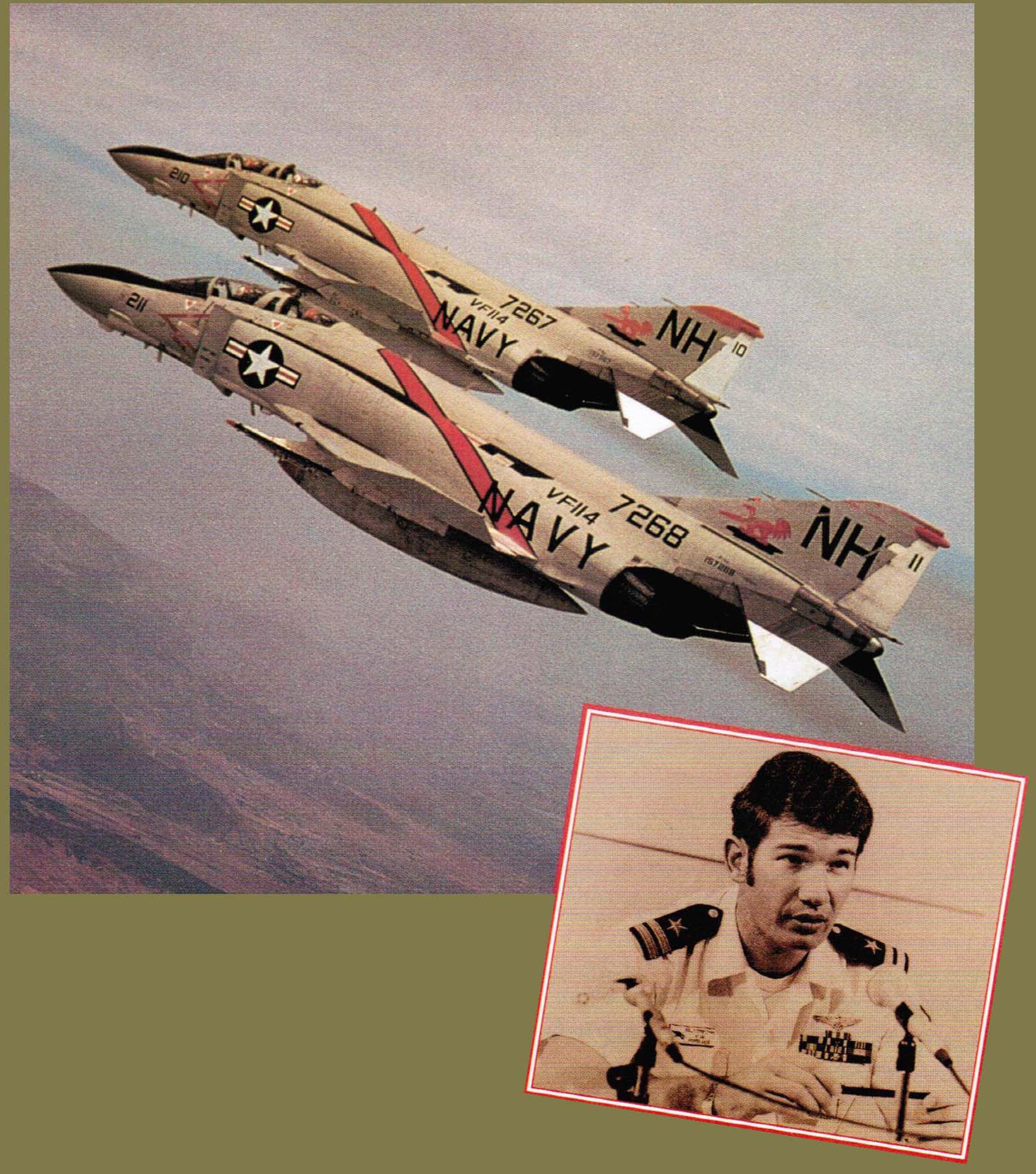
Lt. Randy Cunningham and his RIO Lt. Willie Driscoll scored their third, fourth and fifth kills on May 10, 1972, to become the Navy's only aces of the war in Southeast Asia.
U.S. Navy MiG-killers
Few human exploits compare with fighting in the F-4 Phantom. The big, powerful machine gave both pilot and radar officer the ride of their lives, blasting aloft with twice as much power as other fighters and going into battle armed to the teeth. Designed as a U.S. Navy carrier-based fighter, the Phantom became a jack-of-all-trades, doing many jobs so well that no other warplane met its standard.
With its far-reaching radar, the Phantom was meant to spot the enemy from a great distance and take him clown with a radar-guided missile. It did not always work that way. A small, nimble fighter like the MiG-17 could pose a real danger to the Phantom if it got close enough.
The Phantom was both a fighter and a bomber, capable of unleashing up to 16,000 pounds of bombs. Further, if challenged in the air, the Phantom could fight back. Not surprisingly, the U.S. Navy's air aces in Vietnam flew the Phantom.

"Showtime 100" was the Phantom used by Randy Cunningham and Willie Driscoll on May 10, 1972, to score their three kills. The last was an epic battle against Colonel Tomb, reputedly the leading North Vietnamese ace. On the way home, "Showtime 100" took a SAM hit forcing the crew to bail out over the sea, but they were rescued safely.
F-4J Phantom
By 1972, when Cunningham and Driscoll flew this aircraft to their three MiG victories, the F-4J was the standard shipboard fighter for the U.S. Navy. Because of its size, it could only fly from the larger carriers and could not fit on the small "Essex"-class ships.



SPECIFICATIONS F-4J Phantom
Type: Two-seat carrier-based multirole fighter.
Powerplant: Two 17,900-lb.-thrust General Electric J79-GE-10 turbojets with afterburners.
Max speed: Mach 2.25 or 1,500 m.p.h.
Ceiling: 62,000 ft.
Combat radius: 900 mi.
Weights: Empty 29,700 lb.; loaded 54,600 lb.
Weapons: Typically: four AIM-7 Sparrow radar missiles and four AIM-9 Sidewinder infrared missiles. Maximum: up to 3,000 lb. of bombs beneath fuselage and up to 16,000 lb. of bombs under the wings.
Dimensions:
Span 38 ft. 5 in.
Length 58 ft. 5 in.
Height 16 ft. 3 in.
Wing area 530 sq. ft.
MiG-killers of May 10, 1972
THE NAVY TAKES ON THE MiGs:
May 10, 1972, was the Navy Phantom's big day over Vietnam. Flying from the USS Constellation, sister squadrons VF-92 "Silver Kings" and VF-96 "Fighting Falcons" blasted seven MiGs from the skies between them while a VF-51 crew shot down another for the Navy. To make matters worse for the North Vietnamese, Air Force Phantoms accounted for another three MiGs that day.

FIRST KILL OF THE DAY:
Lt. Curt Dose (seen here demonstrating his dogfight) and Lt. James McDevitt from VF-92 scored the first kill of May 10, after blasting their F-4s down the Kep runway to stir up the MiGs.

TWO MiGs IN ONE DAY: RIO Lt.
Thomas Blonski looks on as his pilot. Lt Matt Connelly, relives one of their duels with MiGs on May 10. Two MiGs fell to their AIM-9 Sidewinders that fateful day.
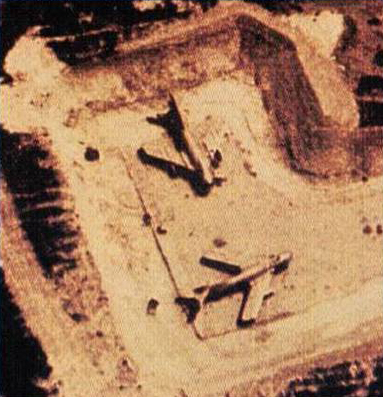
THE FOE:
North Vietnamese MiG-17s cower behind bunkers between missions. Although the faster MiG-21 was available, many experienced pilots, such as Colonel Tomb, favored the nimble "Fresco".
McDonnell Douglas F-4 Phantom

Marines at sea
It wasn't just the Navy that flew the Phantom from aircraft carriers. U.S. Marine Corps squadrons shared the load of shipboard deployments.

Top Guns of the 1960s
In the late 1960s the F-4 Phantom crew was considered the elite of the West's air forces. No service trained their crews better than the U.S. Navy.

Fighter-bomber
The Phantom was best known as a MiG-killer, but it did its fair share of ground attacking as well. These aircraft are seen over Vietnam, dropping 500-lb. bombs from the relative safety of medium altitude.
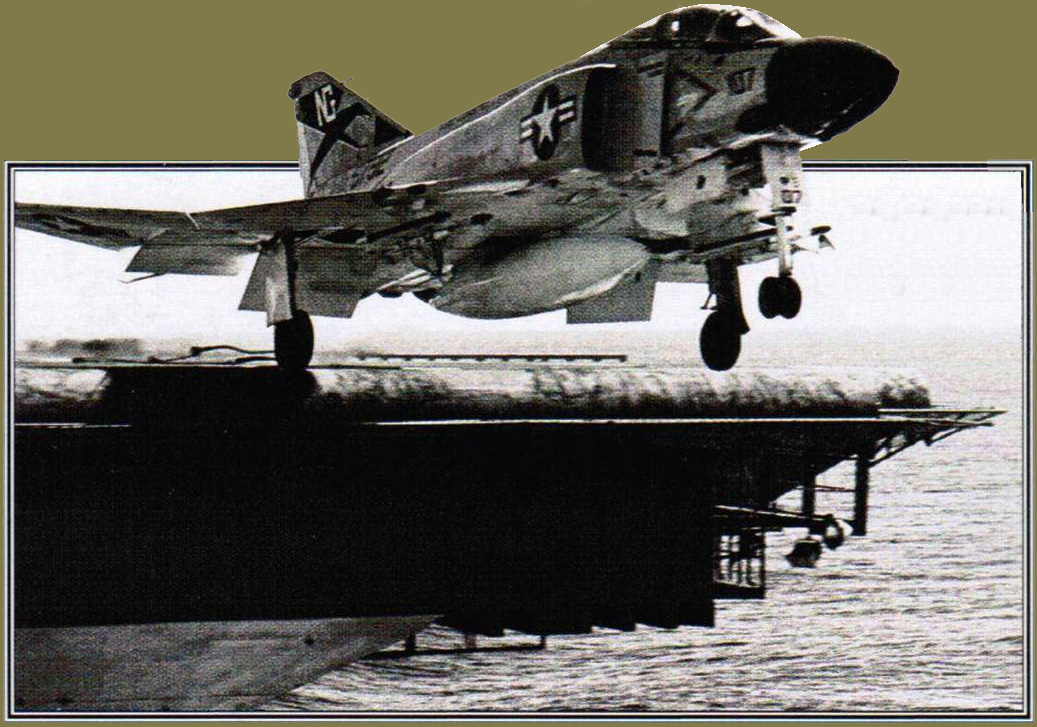
Catapult launch
An F-4J thunders from the deck on an unarmed training sortie. The undercarriage was incredibly strong to absorb the pounding of carrier operations.
FACTS AND FIGURES
▶ Tests showed that pilots in Vietnam were more anxious about landing on the carrier than about fighting MiGs.
▶ Navy and Marine F-4B and F-4J fighters flew over 100,000 sorties in Vietnam.
▶ In early Vietnam combat, Phantom pilots were achieving only a 1:1 kill ratio.
▶ A Phantom weighs 4.68 times as much as the Hellcat carrier fighter of 1944.
▶ After the introduction of "Top Gun" training, the kill ratio improved to as much as seven MiGs for each F-4 lost.
▶ On May 10, 1972, Navy F-4s from fighter squadron VF-96 downed six MiGs.
▶ Multirole strike fighter
▶ Dangerous low-level missions
They flew the most dangerous air missions of the Gulf War. Hurtling through the night, less than 200 feet above the ground, their targets were the heavily defended runways of Iraq's military airfields. And the perilous nature of their role is reflected in the fact that the Royal Air Force's (RAF) Tornado GR.1s suffered proportionally the highest losses of all the aircraft taking part in Operation Desert Storm.

Tornados are designed to fly very fast, very low. Just how low is evident in this view from the cockpit of a Tornado as it races a hundred feet up through a desert "wadi."
Gulf War spearhead
"It was a very, very black night; probably one of the darkest I have ever flown on. Over the desert, especially over Iraq, there are no lights. You are flying very low, and all you see is the odd Bedouin camp flashing by."
From the beginning of the Gulf War, British and Saudi air force Tornados made their trademark high-speed attacks. Passing low over their target, the huge JP233 containers beneath the fuselage dispensed runway-cratering munitions and area- denial mines, designed to prevent repair operations.
Low-level missions such as those employing the JP233 were among the most dangerous of the war. Five aircraft were lost to the full force of enemy antiaircraft artillery.
"It's absolutely terrifying. You're frightened of failure; you're frightened of dying. You're flying as low as you dare but not too low to drop your weapons. You put it over the target as low as possible, then you get away as fast as you can."
The problem was the size and multiple runways of the Iraqi air bases. It didn't take the Tornado pilots long to decide that destroying the taxiways leading to the runways was the most effective way of making the airfield unusable.
The lack of air opposition later in the war testified that the incredible courage of the crews was not wasted, and the Tornado force had done its job.
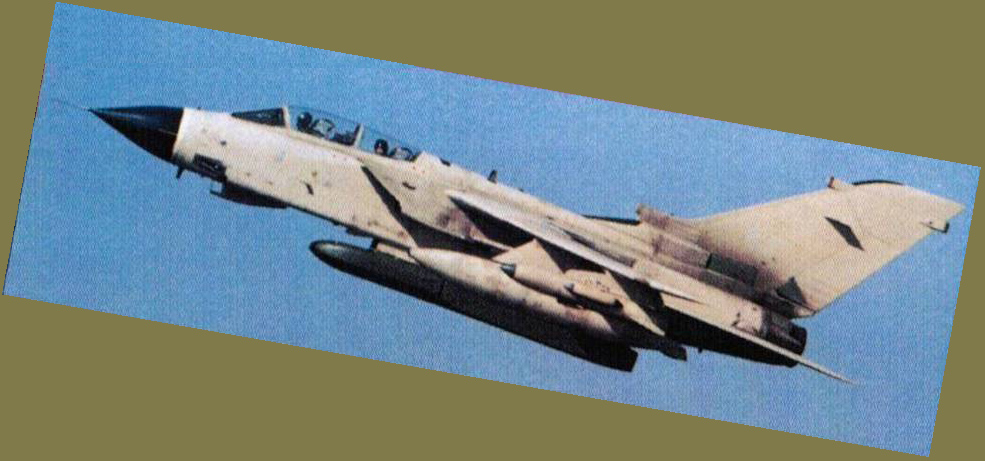
JP233 is no lightweight. Twenty feet long and weighing 5,150 pounds, it needs a powerful machine like the Tornado to carry its twin dispensers.

Tornado GR.1 "MiG-Eater"
British air force Tornados in the Gulf were notable for their colorful nose art. "MiG-Eater," depicted here, was based at Tabuk. It was one of the most heavily used Tornados, being flown on 40 missions.
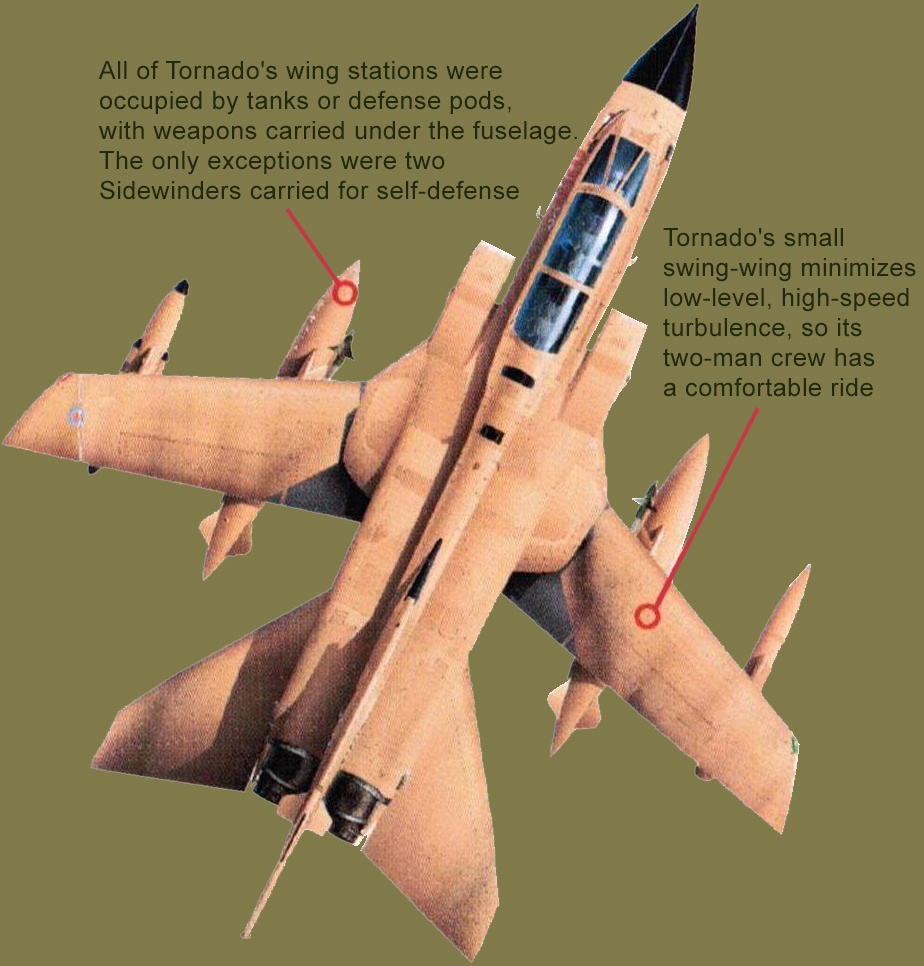
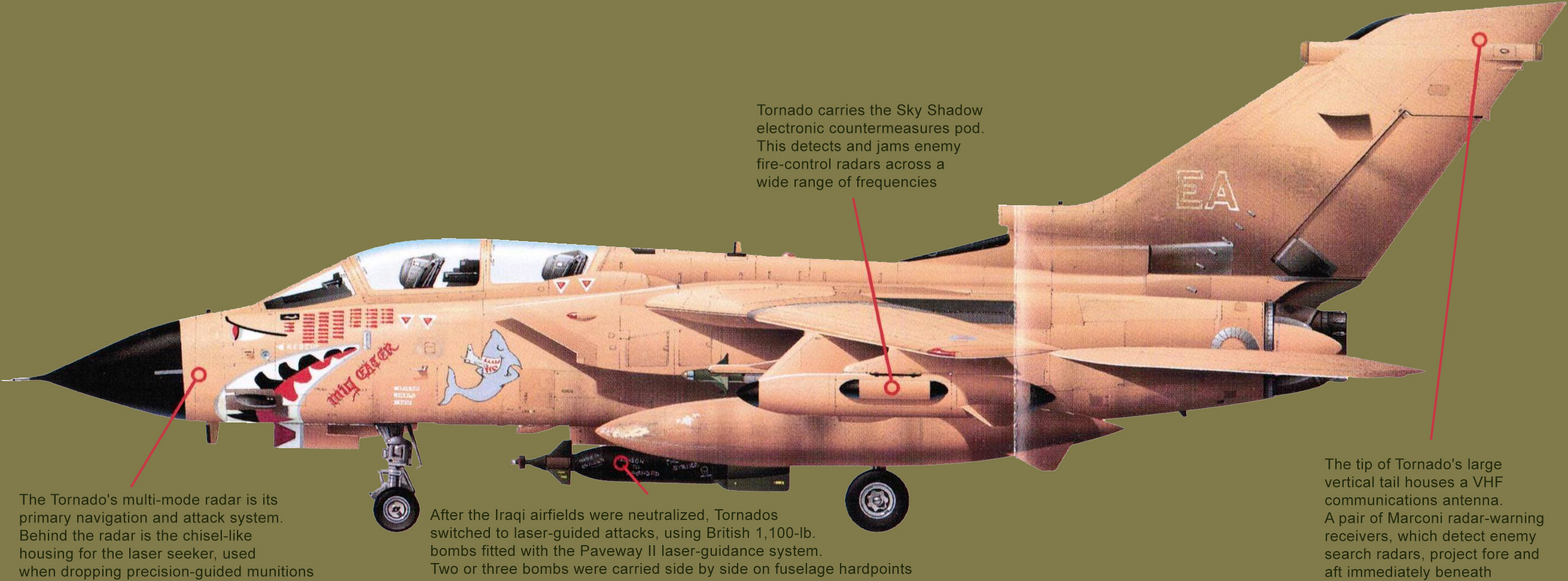
SPECIFICATIONS TORNADO GR.1
Type: Two-seat multirole combat aircraft.
Powerplant: Two Turbo-Union RB.199 Mk103 turbofans, each rated at 8,650 lb. dry and 16,100 lb. afterburning thrust.

Maximum speed: 920 m.p.h. at low level.
Combat radius: 870 mi. on a typical hi-lo-hi attack mission.
Service ceiling: More than 50,030 ft.
Weapons: Two 27-mm IWKA-Mauser cannons each with 180 rounds; 19,840 lb. of ordnance ranging from WE177B nuclear bomb. JP233 or MW-1 airfield attack weapons, Alarm or HARM anti-radar missiles, Paveway laser-guided bombs, and 1,200 lb. free-fall or retarded HE bombs.
Weights: Empty 30,620 lb; loaded 61,620 lb.
Dimensions:
Span (28 ft. sweep) 45 ft. 7 in.
Length 54 ft. 9 in.
Height 19 ft. 6 in.
Wing area 286 sq. ft.

Panavia Tornado GR.1

Low-level attack
JP233 dispenses two types of bomblets. The larger SG357 munition at the rear penetrates a runway before exploding, causing craters. The tiny HB876 mines dispensed from the front are lethal against repair personnel and vehicles.
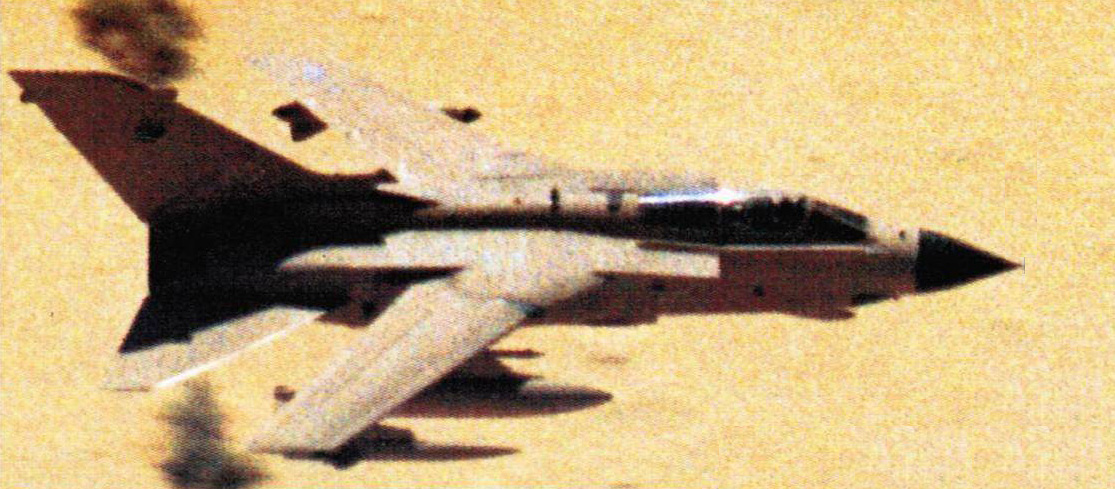
On the deck
Control of this low-flying, exceedingly fast plane is largely automatic. The aircraft's terrain-following radar ensures that a constant ground clearance is maintained.

Multi-mission
The nose of Tornado "MiG-Eater" records three JP233 missions, 23 bombing missions and 14 laser-guided bombing missions.
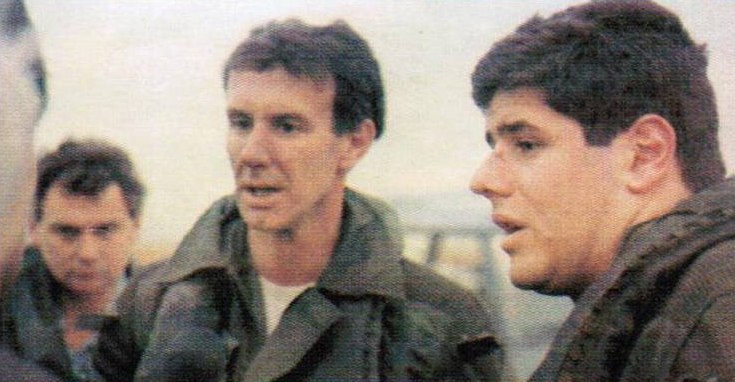
First mission
Strain shows on the faces of a returning Tornado crew after the first night's mission, along with relief at having survived unscathed.

Low-flying danger
Some crewmen, like Jon Peters (inset), managed to survive being shot down, getting out of their shattered Tornados only to suffer mistreatment at the hands of their captors.
FACTS AND FIGURES
▶ On the first three nights of the war Tornados flew 63 sorties, delivering JP233 runway attack munitions.
▶ Airfields hit included Al Asad, H-2, H-3, Shaibah, Tallil, Al Taqaddum and Ubaidah.
▶ Four Tornados were lost in the first five days, although only one carried JP233.
▶ Six RAF Tornados were lost in action, five crew members killed and seven captured.
▶ British Tornados flew a total of 1,600 bombing missions during the war, or 1.4 percent of the coalition total.
▶ Tornados delivered 100 JP233s, 4,250 free-fall bombs and 950 laser-guided bombs.
We have much more interesting information on this site.
Click MENU to check it out!
∎ cartalana.com© 2009-2025 ∎ mailto: cartalana@cartalana.com